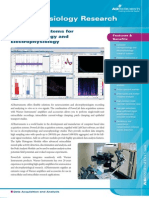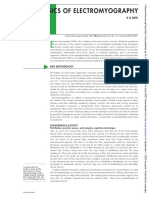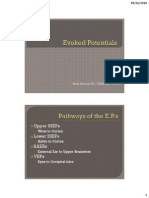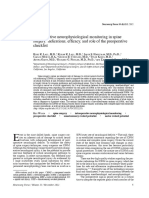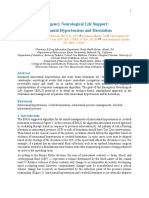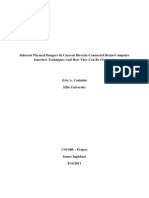Neurophysiologic Basis of EEG: Piotr Olejniczak
Neurophysiologic Basis of EEG: Piotr Olejniczak
Uploaded by
ioanviCopyright:
Available Formats
Neurophysiologic Basis of EEG: Piotr Olejniczak
Neurophysiologic Basis of EEG: Piotr Olejniczak
Uploaded by
ioanviOriginal Title
Copyright
Available Formats
Share this document
Did you find this document useful?
Is this content inappropriate?
Copyright:
Available Formats
Neurophysiologic Basis of EEG: Piotr Olejniczak
Neurophysiologic Basis of EEG: Piotr Olejniczak
Uploaded by
ioanviCopyright:
Available Formats
ORIGINAL ARTICLES
Neurophysiologic Basis of EEG
Piotr Olejniczak
Summary: This review article introduces the reader to the very basics of electroencephalography (EEG). It tries to explain in simple terms the physiologic principles of EEG generation and organization at the cellular, cortical and subcortical levels. It also introduces the basic EEG terminology (see the key words). Key Words: EEG, Postsynaptic potentials, Volume conduction, Propagation, Synchronization, Desynchronization. (J Clin Neurophysiol 2006;23: 186189)
EEG DEFINITION What is EEG?
Electroencephalography is a graphic representation of the difference in voltage between two different cerebral locations plotted over time. The scalp EEG signal generated by cerebral neurons is modied by electrical conductive properties of the tissues between the electrical source and the recording electrode on the scalp, conductive properties of the electrode itself, as well as the orientation of the cortical generator to the recording electrode (Fig. 1).
VOLUME CONDUCTION
The EEG can be obtained because of the process of current ow through the tissues between the electrical generator and the recording electrode, which is called volume conduction. EEG provides a two-dimensional projection of three-dimensional reality, which means that theoretically it is impossible to determine the location of the EEG generator based on scalp-recorded EEG information alone. This is referred to as the inverse problem.
tinuum. Only synaptic activity readily fullls those criteria and is most signicant source of EEG potentials. Each synapse acts like a battery driving current in a small loop. Both excitatory postsynaptic potentials (EPSPs) and inhibitory postsynaptic potentials (IPSPs) contribute to the synaptic activity recorded as EEG (Fig. 2). The summation of extracellular currents is slow enough to be able to generate EEG potentials. The current owing across the external resistance of the cortex sums with the loop currents of the neighboring neurons to constitute a local mean eld (Fig. 3). Viewed from outside the cells, membrane areas where current ows in or out of the cells are called respectively sinks and sources. Excitatory currents, involving Na or Ca2 ions, ow inward toward an excitatory synapse and outward away from it. The outward current is referred as a passive return current (from intracellular to extracellular space). Inhibitory loop currents, involving Cl and K ions, ow in the opposite direction. Scalp electrodes record potential differences that are caused by postsynaptic potentials in the cell membrane of cortical neurons. The closed loops of the lighter dashed lines represent the summation of extracellular currents produced by the postsynaptic potentials; the open segments of heavier dashed lines connect all points having the same voltage level. The two scalp electrodes are at different voltage levels and record this difference (Fig. 4).
NONSYNAPTIC CONTRIBUTIONS TO EEG
The nonsynaptic activity is a less signicant source of extracellular current ow that produces EEG potentials. Intrinsic neuronal activity such as fast action potentials usually lasts too short to affect EEG. Nonsynaptic intercellular interactions may potentially contribute to EEG (Buzsaki, Traub and Pedley, 2003)
SYNAPTIC SOURCES OF EEG
To visualize and monitor minute (in the microvolt range) cerebral electrical activity, it must be of sufcient duration and sustained strength. To put it facetiously, one has to nd a platform on which both the examiner and the examined brain nd themselves in the same time-space con-
INTRINSIC NEURONAL SOURCES OF EEG
Short-lasting ( 2 s) high-amplitude individual fast (Na ) action potentials do not contribute to scalp recorded potentials except during synchronous events both physiologic such as sleep transients and pathologic such as epileptic activity. Calcium-mediated action potentials (calcium spikes) are voltage generated and occur synchronously with dendritic EPSPs. They can contribute to the creation of the dendritic eld sinks, especially during epileptiform activity
Epilepsy Center of Excellence at the LSU Health Sciences Center in New Orleans, Louisiana, U.S.A. Paper presented on 12-02-2005 at the course EEG: The Basics during the Joint Meeting of the American Epilepsy Society and the American Clinical Neurophysiology Society in Washington, D.C. Address correspondence and reprint requests to Dr. Piotr Olejniczak, Louisiana State University Healthcare Network, 5329 Didesse Street, Baton Rouge, LA 70815, U.S.A.; e-mail: polejn@lsuhsc.edu. Copyright 2006 by the American Clinical Neurophysiology Society ISSN: 0736-0258/06/2303-0186
INTRINSIC SPIKE AFTERHYPERPOLARIZATION
Intrinsic spike afterhyperpolarization (AHP) following dendritic Ca2 spikes results in suppression of fast spikes and
186
Journal of Clinical Neurophysiology Volume 23, Number 3, June 2006
Journal of Clinical Neurophysiology Volume 23, Number 3, June 2006
Neurophysiologic Basis of EEG
FIGURE 1. Simultaneous intracranial and scalp EEG recording of a temporal lobe seizure. The channels in the upper third of the picture represent intracranial contacts, whereas the ones in the lower part represent the scalp contacts. The intracranial recording appears to be generally more regular and of higher amplitude then the scalp one, which appears to be attenuated (from Ebersole, 2003)
FIGURE 2. Generation of extracellular voltage fields from graded synaptic activity (from Martin, 1991). Relationship between polarity of surface potentials and site of dendritic postsynaptic potentials.
hyperpolarization of the membrane caused by activation of the Ca2 -mediated K conductance. These AHPs are comparable in amplitude and duration to the synaptic events, and as such, may contribute to extracellularly recorded EEG potentials. An example of AHPs may be the generation of delta waves in sleep. In the awake brain, subcortical neurotransmitters such as acetylcholine, catecholamines and histamine reduce the calcium-mediated potassium conductance, blocking the AHP-related delta waves.
cium inux into the neurons. Postictally increased K levels produce propagating waves across the astrocytes manifested by slowly spreading sustained potentials. Astrocytes release more K , that way depolarizing the neurons and blocking the afterdischarge with resulting postictal depression.
CORTICAL GENERATORS OF EEG
The main sources of EEG derive from cerebral cortex and form three-dimensional potential elds, which can be recorded as projected two-dimensional elds in the function of voltage versus time. It takes a combined synchronous electrical activity of approximately 108 neurons in a cortical area of minimum 6 cm2 to create visible EEG. The area of cortex required for the generation of interictal spikes may be as large as 20 cm2. As mentioned earlier, the principal generators of EEG elds measured on the surface of the brain or at the scalp are graded synaptic potentials; i.e., EPSPs and IPSPs of the pyramidal neurons. At the synaptic site of an EPSP there is an active current sink (extracellular negative eld). Positive ions migrate to the cell and depolarize the membrane. At the distal part of the cell (body and distal dendrites) a passive current source out of the cell is associated with extracellular positive eld. EEG elds are primarily generated by the large, vertically oriented pyramidal neurons located in cortical layers III, V, and VI. Because of the attenuating properties of the skull, spatial (i.e., tridimensional) summation of cortical activity is critical for producing a voltage eld recordable from the scalp.
NONSYNAPTIC CELLULAR INTERACTIONS
Evoked ephaptic effects may change transmembrane potentials creating extracellular current loops that can recruit neurons to re even with insufcient activation by synaptic inputs. Ultrafast cortical rhythms result from short-lived interactions between interneurons and pyramidal cells that may produce a short-lived oscillatory eld potential (ripple) in both hippocampus and neocortex. Although not recorded by standard EEG equipment, they may be diagnostically significant harbingers of seizure onset and offset.
NEURONGLIA INTERACTIONS
The astrocytes are connected by gap junctions that allow spread of current and diffusion of molecular transport. This coupling allows spreading Ca2 waves triggering calCopyright 2006 by the American Clinical Neurophysiology Society
187
P. Olejniczak
Journal of Clinical Neurophysiology Volume 23, Number 3, June 2006
FIGURE 3. Schematic of a brain cross section, illustrating four representative cortical EEG sources (from Ebersole, 2003). Sources 2 and 3 produce radial fields, so the negative, so the negative voltage maximum is directly above them. Sources 1 and 4 produce tangential fields and both negative and positive voltage maxima are displaced to either side.
RELATIONSHIP BETWEEN POLARITY OF SURFACE POTENTIALS AND SITE OF DENDRITIC POSTSYNAPTIC POTENTIALS
Source area is maximal for a given electrode when the orientation of the active cortical region is face-on. This is the case when the voltage eld is radial and electrode right above the source. A radial source produces eld maximal directly above it, and another one with opposite polarity on the opposite side of the head. For a supercial source, the scalp maximum nearest it is signicantly greater than the one on the opposite side of the head. Single-voltage eld maximum cannot be used to dene the location and/or orientation of a cortical EEG generator. Except for a purely radial source, the EEG eld maxima are displaced from a position directly above it. The location of both negative and positive eld maxima and their relative strengths must be taken into consideration.
FIGURE 4. Relationship between EEG slow waves and thalamic intracellular potentials (from Steriade et al., 1993).
PROPAGATION OF CORTICAL ACTIVATION
With propagation of electrical activity into adjacent cortical regions, the geometry of the source changes. New location and new orientation of the source take place resulting in a different voltage eld. Movement of scalp eld maxima over tens of milliseconds suggests propagation of source activity.
SUBCORTICAL SYNCHRONIZATION OF EEG
The dorsal thalamus is considered as the chief subcortical EEG rhythm generator synchronizing populations of neocortical neurons as voltage generators. In normal conditions both thalamic nuclei and cortical regions interact to
produce the synchrony of cortical postsynaptic potentials (PSPs) during wakefulness and sleep. The facultative pacemaker theory assumes that thalamocortical relay neurons send bers to the cortex as well as give off branches that turn back and end on thalamic inhibitory interneurons (biofeedback servomechanism). Nucleus reticularis hypothesis attributes the pacemaker properties to the nucleus reticularis thalami, whose cells release the inhibitory neurotransmitter GABA in rhythmic bursts of depolarizations directed to the neurons of the dorsal thalamus and rostral brainstem. Alpha-frequency rhythms are generated in multiple cortical areas in addition to the occipitally dominant alpha rhythm. Local cortical connections seem to be more important in generating most alpha-frequency rhythms, although thalamocortical discharges may have limited inuence on posterior dominant alpha rhythm. Fast waking rhythms such as in beta- and gammafrequency bands are produced by cortical generators. Pontine cholinergic input to the thalamus inhibits the generators producing sleep transients such as sleep spindles and highamplitude delta waves. Sleep spindles appear to be a thalamocortical phenomenon. GABAergic neurons of the nucleus reticularis thalami discharge in rhythmic cycles. They project to thalamocortical relay neurons, which in turn project to widespread cortical neurons. The relay neurons discharge after GABA-release related inhibition subsides. That subsequently results in synchronized EPSPs in the cortex, which become visible by EEG.
Copyright 2006 by the American Clinical Neurophysiology Society
188
Journal of Clinical Neurophysiology Volume 23, Number 3, June 2006
Neurophysiologic Basis of EEG
Unlike sleep spindles, which require synaptic activities to establish the rhythmic oscillation, delta oscillation is an intrinsic rhythm that depends on potassium uxes at voltagedependent ion channels of cortical and thalamic neurons.
occur in the setting of widespread injury to the ascending neuronal systems that would otherwise produce arousal and desynchronization.
SUBCORTICAL EEG DESYNCHRONIZATION
Desynchronization of the EEG is the interruption of its rhythmical activity. It occurs with activation of ascending cholinergic projections of the basal forebrain and brainstem and projections from the raphe nuclei and locus ceruleus. Rhythmical activity is interrupted by both direct effects on cortical neurons and indirectly on thalamic neurons. At the cellular level, desynchronization is accompanied by a transition from a burst ring pattern to more continuous or single spike pattern. Desynchronization is enhanced by behavioral arousal and suppressed by non-REM sleep. Certain abnormal synchronous patterns, such as alpha coma,
REFERENCES
Buzsaki G, Traub RD, Pedley TA. The cellular basis of EEG activity. In: Ebersole JS, Pedley TA, eds. Current practice of clinical electroencephalography. 3rd ed. Philadelphia: Lippincott Williams and Wilkins, 2003:111. Ebersole JS. Cortical generators and EEG voltage elds. In: Ebersole JS, Pedley TA, eds. Current practice of clinical electroencephalography. 3rd ed. Philadelphia: Lippincott Williams and Wilkins, 2003:1231. Fisch BJ. Fisch and Spehlmanns EEG primer. Amsterdam: Elsevier, 1999. Martin JH. The collective electrical behavior of cortical neurons: the electroencephalogram and the mechanisms of epilepsy. In: Kandel ER, Schwartz JH, Jessel TM, eds. Principles of neural science. Norwalk: Appleton and Lange, 1991:77791. Steriade M, McCormick DA, Sejnowski T. Thalamocortical oscillations in the sleeping and aroused brain. Science. 1993;262:67985.
Copyright 2006 by the American Clinical Neurophysiology Society
189
You might also like
- Trusted Neurodiagnostics Academy Study Guide BookDocument347 pagesTrusted Neurodiagnostics Academy Study Guide BookDave RiveraNo ratings yet
- Clinical Electroencephalography and Topographic Brain Mapping - Technology and Practice (PDFDrive)Document313 pagesClinical Electroencephalography and Topographic Brain Mapping - Technology and Practice (PDFDrive)marceloheitor100% (1)
- Learning and Memory 3rd Edition Gluck Test BankDocument26 pagesLearning and Memory 3rd Edition Gluck Test Banklaurenhaynesnjqcdgotay100% (15)
- Stimulation and Transcranial Direct Current StimulationDocument453 pagesStimulation and Transcranial Direct Current StimulationMarcelo LugonNo ratings yet
- ACNS Training Module 2022-01-01 Combined FINALDocument153 pagesACNS Training Module 2022-01-01 Combined FINALAndres Rojas Jerez100% (1)
- Rubin 2012 - NCL - Pitfalls of NCS and Needle EMGDocument27 pagesRubin 2012 - NCL - Pitfalls of NCS and Needle EMGanjelikaNo ratings yet
- Wacp Primary Curriculum For Psychiatry PDFDocument5 pagesWacp Primary Curriculum For Psychiatry PDFowusuesselNo ratings yet
- Nervous WorksheetDocument2 pagesNervous WorksheetJaenicaPaulineCristobalNo ratings yet
- EEG Anubhav 071221Document58 pagesEEG Anubhav 071221Harsh TanwarNo ratings yet
- Practicals NeurophysiologyDocument36 pagesPracticals NeurophysiologysridharNo ratings yet
- Basic Ep Emg Sec1 - CurntDocument205 pagesBasic Ep Emg Sec1 - Curntersha menggaNo ratings yet
- Nerve Conduction StudiesDocument5 pagesNerve Conduction Studiesأحمد عطيةNo ratings yet
- Emg PDFDocument10 pagesEmg PDFIvan IsaackNo ratings yet
- Visual Evoked PotentialDocument32 pagesVisual Evoked PotentialKota Anuroop100% (1)
- TCD ProtokolDocument35 pagesTCD Protokolscepan100% (1)
- First Seizure: EEG and Neuroimaging Following An Epileptic SeizureDocument7 pagesFirst Seizure: EEG and Neuroimaging Following An Epileptic SeizureheribertoNo ratings yet
- 02 Normal ''Suspicious'' EEGDocument10 pages02 Normal ''Suspicious'' EEGasNo ratings yet
- Abret 1Document17 pagesAbret 1academicexcellence21100% (1)
- The New Clasification ILAE 2017Document6 pagesThe New Clasification ILAE 2017Ami D ALNo ratings yet
- EMG Summary: Muscle MNDocument12 pagesEMG Summary: Muscle MNanjelikaNo ratings yet
- Ulnar NeuropathyDocument24 pagesUlnar NeuropathypaulosantiagoNo ratings yet
- Intraoperative Neurophysiologic MonitoringDocument7 pagesIntraoperative Neurophysiologic MonitoringMustaqim PrasetyaNo ratings yet
- Nerve Conduction StudiesDocument10 pagesNerve Conduction StudiesRyanNo ratings yet
- Neurophysiology 2010decDocument8 pagesNeurophysiology 2010decAgung Iman SantosoNo ratings yet
- SFMGDocument14 pagesSFMGRajshekher GarikapatiNo ratings yet
- EEG MaturationDocument29 pagesEEG Maturationhm3398No ratings yet
- Neuroanatomy - Carpenter 9E (1996)Document1,025 pagesNeuroanatomy - Carpenter 9E (1996)scribdarnabNo ratings yet
- The Basics of ElectromyographyDocument4 pagesThe Basics of ElectromyographyCamila MendezNo ratings yet
- Evoked Potentials & TrmorographyDocument8 pagesEvoked Potentials & TrmorographyHassan Bani SaeidNo ratings yet
- Electrodiagnosis: Nerve Conduction and Electromyography. Chapman's Comprehensive Orthopaedic Surgery, 4th Ed., Chapter 261.Document15 pagesElectrodiagnosis: Nerve Conduction and Electromyography. Chapman's Comprehensive Orthopaedic Surgery, 4th Ed., Chapter 261.Gorilinha Hidalginho100% (1)
- The Neurobiology of Abnormal Manifestations of AggressionDocument13 pagesThe Neurobiology of Abnormal Manifestations of AggressionfernandogfcnsNo ratings yet
- Eeg NcsDocument5 pagesEeg NcsFathy ShaabanNo ratings yet
- Evoked Potentials - BNDocument48 pagesEvoked Potentials - BNlucia100% (1)
- NeuromonitoringDocument10 pagesNeuromonitoringPankaj VatsaNo ratings yet
- Emergency Neurological Life Support: Intracranial Hypertension and HerniationDocument23 pagesEmergency Neurological Life Support: Intracranial Hypertension and HerniationElisabeth Permatasari SidabutarNo ratings yet
- Lawrence J. Hirsch, Michael W. K. Fong, Richard Brenner - Hirsch and Brenner's Atlas of EEG in Critical Care-Wiley-Blackwell (2023)Document579 pagesLawrence J. Hirsch, Michael W. K. Fong, Richard Brenner - Hirsch and Brenner's Atlas of EEG in Critical Care-Wiley-Blackwell (2023)Stefan100% (2)
- Workshop E - Bundle 2019 - Electro-274-295Document22 pagesWorkshop E - Bundle 2019 - Electro-274-295adaptacion neonatal100% (1)
- Potenciales Evocados Aaitif M HusainDocument325 pagesPotenciales Evocados Aaitif M HusainMariela Oliva mondragon100% (1)
- Needle EMG Muscle IdentificationDocument13 pagesNeedle EMG Muscle Identificationemilio9fernandez9gat100% (1)
- ILAE Classification of Seizures and EpilepsyDocument19 pagesILAE Classification of Seizures and EpilepsyIRENA GENI100% (1)
- 12 THE Nervous System and Nervous TissueDocument98 pages12 THE Nervous System and Nervous TissueolivNo ratings yet
- (Progress in Epileptic Disorders, Vol. 13) Solomon L. Moshé, J. Helen Cross, Linda de Vries, Douglas Nordli, Federico Vigevano-Seizures and Syndromes of PDFDocument283 pages(Progress in Epileptic Disorders, Vol. 13) Solomon L. Moshé, J. Helen Cross, Linda de Vries, Douglas Nordli, Federico Vigevano-Seizures and Syndromes of PDFWalter Huacani HuamaniNo ratings yet
- EEG Literature ReviewDocument12 pagesEEG Literature Reviewh_silent_rain100% (2)
- ElectromyographyDocument15 pagesElectromyographyAnonymous -No ratings yet
- Book Matter - AtlasOf EpilepsiesDocument55 pagesBook Matter - AtlasOf EpilepsiesDhamara AdhityaNo ratings yet
- Pediatric EpilepsyDocument6 pagesPediatric EpilepsyJosh RoshalNo ratings yet
- Evoked PotentialsDocument591 pagesEvoked PotentialsPablo EmilioNo ratings yet
- (Natoc 1Document495 pages(Natoc 1Entre100% (1)
- Evoked Potential Normative DataDocument3 pagesEvoked Potential Normative Datachardolin0% (1)
- Lower Motor Neuron (LMN) Facial Palsy: Department of ENTDocument32 pagesLower Motor Neuron (LMN) Facial Palsy: Department of ENTalfaz lakhani100% (1)
- Recent Advances in Clinical Electroencephalography.134Document7 pagesRecent Advances in Clinical Electroencephalography.134yuly.gomezNo ratings yet
- Sample Emg/Ncv Report - Normal StudyDocument5 pagesSample Emg/Ncv Report - Normal StudyPhysiotherapist AliNo ratings yet
- The Use of Surface EMG in Biomechanics PDFDocument38 pagesThe Use of Surface EMG in Biomechanics PDFMarshall BananaNo ratings yet
- Normal EEG Patterns in Infants A Children - Textbook.finalDocument11 pagesNormal EEG Patterns in Infants A Children - Textbook.finalJucsy JuxyNo ratings yet
- Carpal Tunnel Syndrome - Clinical Manifestations and Diagnosis - UpToDateDocument15 pagesCarpal Tunnel Syndrome - Clinical Manifestations and Diagnosis - UpToDateFajar HerbowoNo ratings yet
- Nerve Conduction Velocity: Karunakaran K MPT (Neuro) ., PGDMT Associate Professor, SvcoptDocument30 pagesNerve Conduction Velocity: Karunakaran K MPT (Neuro) ., PGDMT Associate Professor, SvcoptSineka 19170239No ratings yet
- Principle of ElectroDx by Dr. Angkana Nudsasarn, Chiang Mai UniversityDocument113 pagesPrinciple of ElectroDx by Dr. Angkana Nudsasarn, Chiang Mai UniversitySurat Tanprawate100% (3)
- NeedleEMG Fundamentals (David Shapiro)Document36 pagesNeedleEMG Fundamentals (David Shapiro)Shauki AliNo ratings yet
- Basic Principles of QEEGDocument7 pagesBasic Principles of QEEGdasilvaseamaNo ratings yet
- Electroencephalography: Electroencephalography-based mind reading is no longer just a fantasy; it may be a reality in the near futureFrom EverandElectroencephalography: Electroencephalography-based mind reading is no longer just a fantasy; it may be a reality in the near futureNo ratings yet
- ElectroEncephaloGraphics: A Novel Modality For Graphics Research: DissertationFrom EverandElectroEncephaloGraphics: A Novel Modality For Graphics Research: DissertationNo ratings yet
- Standard Electroencephalography in Clinical Psychiatry: A Practical HandbookFrom EverandStandard Electroencephalography in Clinical Psychiatry: A Practical HandbookNo ratings yet
- The Epilepsy Aphasias: Landau Kleffner Syndrome and Rolandic EpilepsyFrom EverandThe Epilepsy Aphasias: Landau Kleffner Syndrome and Rolandic EpilepsyNo ratings yet
- Second Year Anaphy FoundTopic StudyReviewGuideDocument41 pagesSecond Year Anaphy FoundTopic StudyReviewGuideBULTOKACHINo ratings yet
- Session #10 SAS - AnaPhy (Lab)Document4 pagesSession #10 SAS - AnaPhy (Lab)G INo ratings yet
- Kendriya Vidyalaya Gachibowli, Gpra Campus, Hyd-32: Subject: ScienceDocument8 pagesKendriya Vidyalaya Gachibowli, Gpra Campus, Hyd-32: Subject: ScienceEr Purushottam PalNo ratings yet
- The Human BrainDocument21 pagesThe Human Brainjamjam_95678853No ratings yet
- Invention Does Not Exist ScribdDocument21 pagesInvention Does Not Exist ScribdBranko R BabicNo ratings yet
- Mod 2Document30 pagesMod 2mailtopiyush18No ratings yet
- Join 4 Smiles Ppt11Document68 pagesJoin 4 Smiles Ppt11Sanjay AsthanaNo ratings yet
- Bio e Let Ro MagntismDocument642 pagesBio e Let Ro MagntismTableOfContents100% (1)
- Escourolle & Poirier's Manual of Basic Neuropathology - 5E (2014) (PDF) (UnitedVRG)Document421 pagesEscourolle & Poirier's Manual of Basic Neuropathology - 5E (2014) (PDF) (UnitedVRG)chysa100% (4)
- Synapse StructureDocument34 pagesSynapse Structuredr_mohanad100% (1)
- Final Exam (ELS) 2019Document7 pagesFinal Exam (ELS) 2019Karl Angelo JustineNo ratings yet
- AP Psychology: Unit 3 VocabDocument2 pagesAP Psychology: Unit 3 VocabSam SankarNo ratings yet
- Kisi2 Biology Fe s4 Sem 2Document15 pagesKisi2 Biology Fe s4 Sem 2Livia XoxoNo ratings yet
- Reflexes and Reaction Times: Student HandoutDocument7 pagesReflexes and Reaction Times: Student HandoutRema AkilNo ratings yet
- Pre-Assessment: Odd Organ OutDocument45 pagesPre-Assessment: Odd Organ OutMelody Miras MacabontocNo ratings yet
- MCQs On Neurons Nerve ImpulseDocument6 pagesMCQs On Neurons Nerve Impulsekombe mukobeNo ratings yet
- Animal Form and Function Gen Bio IIDocument73 pagesAnimal Form and Function Gen Bio IIPalad , John Carlo BernabeNo ratings yet
- Brain ThesisDocument6 pagesBrain ThesisHolly Fisher100% (2)
- Memory Genius PDFDocument37 pagesMemory Genius PDFAditya RajNo ratings yet
- PROJECT On Stress Management by Karan Pathak FinalDocument85 pagesPROJECT On Stress Management by Karan Pathak FinalKaran pathakNo ratings yet
- Handbook of Practical ElectrotherapyDocument162 pagesHandbook of Practical ElectrotherapySilvano Cardona86% (21)
- Unit 1 Part 3 SignallingDocument32 pagesUnit 1 Part 3 SignallingAnn NguyenNo ratings yet
- In Text Questions: NCERT Solutions For Class 10th: CH 7 Control and Coordination ScienceDocument8 pagesIn Text Questions: NCERT Solutions For Class 10th: CH 7 Control and Coordination ScienceJignesh KiriNo ratings yet
- NATE Module 2 - Week 8 - 1 PDFDocument26 pagesNATE Module 2 - Week 8 - 1 PDFKoushik V PrasadNo ratings yet
- (Download PDF) Language of Medicine 10th Edition Chabner Test Bank Full ChapterDocument50 pages(Download PDF) Language of Medicine 10th Edition Chabner Test Bank Full Chapterdietzishil100% (7)
- Eric Cosimini BCI Research PaperDocument33 pagesEric Cosimini BCI Research PaperEric CosiminiNo ratings yet
- AIML 4th and 5th Module NotesDocument77 pagesAIML 4th and 5th Module Noteslekhanagowda797No ratings yet























